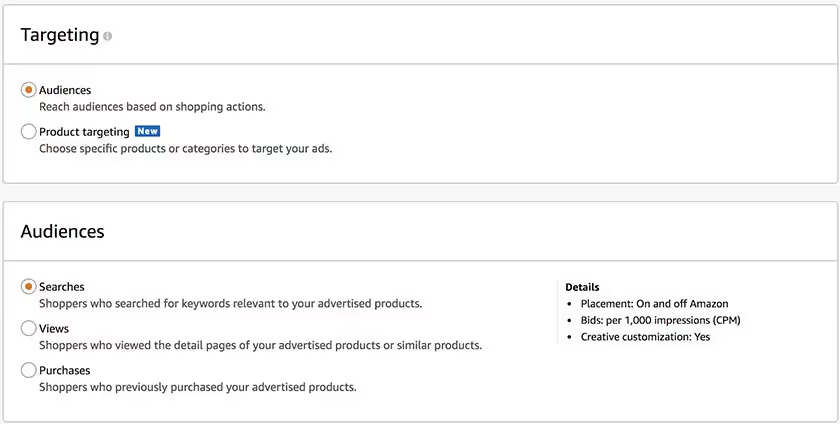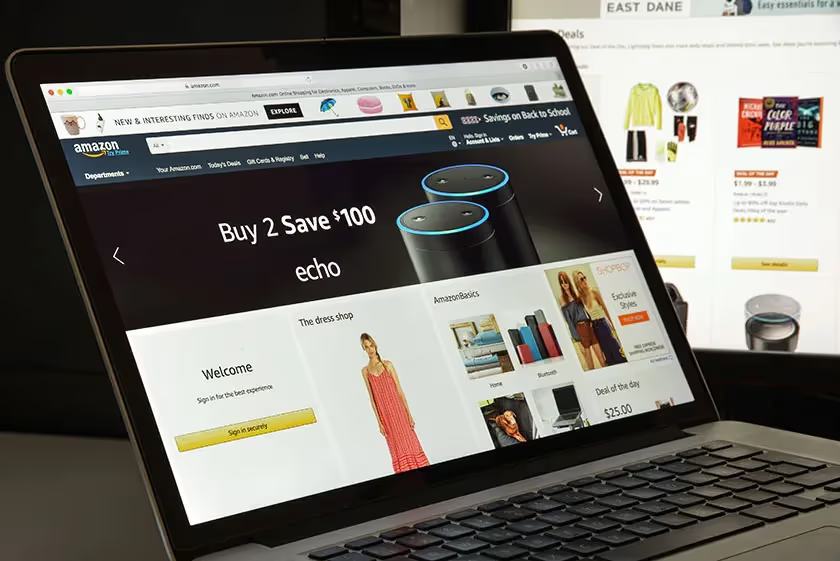How to Leverage Sponsored Display Ads to Increase Sales
Product display ads can increase your RoAS and help you win over indecisive customers. Pattern's ecommerce experts explain how to leverage product display on Amazon.
We advertise to increase sales, develop more brand awareness, or beat out our competitors. Sponsored Display Ads target customers in a way that can meet ALL of those goals instead of just one with its unique targeting capabilities.Of course, Sponsored Product Ads and Sponsored Brand Ads are everyone’s go-to, making them seem more favored, but that just allows you to own the Sponsored Display Ad space that much quicker.For a quick history lesson, Sponsored Display ads used to be called ‘Product Display Ads,’ or PDAs. They were ads that were only accessible through Vendor central. Amazon has since changed this so now all sellers have the opportunity to utilize these ads.
What are Sponsored Display Ads?
Like sponsored product or sponsored brand ads, sponsored display ads are PPC (pay-per-click) campaigns. They are used to market single products directly at the point of sale—below the Buy Box or bullet points on detail pages. These ads receive a prominent placement and good visibility to buyers.

One thing you cannot do with the other ad products is retarget based on consumer shopping behavior. Sponsored display ads allow you to do this three different ways:
- Purchases: You can serve ads to people who have previously purchased your products.
- Views: You can serve ads to people who viewed the detail pages of your products.
- Searches: You can serve ads to people who searched for similar product.

Sponsored Display also allows you to target specific products similar to Product targeting within Sponsored Products. But that has been around for a few years now and was once called “Product Display Ads.” I want to focus more on the new audience targeting features listed above.Let’s take a look at these different methods and some of the ways they can be utilized to grow your brands.
1. Searches—Shoppers who searched for keywords relevant to your advertised products
Although display ads are usually to target bottom-of-funnel customers, they can also be useful for buyers who are earlier into their buying journey. If you’re targeting your customers correctly, you’re getting visibility and top-funnel exposure to the exact audience you want. They may not click through and purchase your item immediately, but they’re now in your marketing funnel and aware of the brand.Using sponsored display to target people who are searching for products similar to yours is a way to make sure that your awareness spending is spent on people who are like your current customers, and who are closer to being ready to try your brand.Remember, these ads can appear on the detail page of a product, and can even appear off of Amazon. So a consumer can search for a baby monitor on amazon, decide to wait, and then be served an ad for Owlet’s Baby Monitor when they are scrolling on a different amazon affiliate site.Can’t I use Sponsored Products and bid on the keywords similar to my product?Yes you can, and you should. However, these ad placements are completely different. Instead of allowing the potential customer to only see your ad on the search results page and on the “Sponsored Products related to this item” carousel, you are opening up the opportunity for them to be exposed to your brand in more places.Can’t I use Amazon DSP for off platform targeting?Yes, absolutely! However the cost structure is different. DSP is a CPM model, meaning that you are paying for the impressions. Whereas Sponsored Display is a CPC model, so you are only paying when they click.Since click-through is low on DSP, those impressions won’t cost an arm and a leg through Sponsored Display. In addition, they’ll be much more targeted due to the behavior targeting we are utilizing.
2. Views—Shoppers who viewed the detail pages of your advertised products or similar products
When you are advertising to grow your brand, one of the most important things to do is focus a lot of your advertising spend on brand awareness. Once you believe you have captured everyone who is in the final stages of the advertising funnel, you need to work your way to broader audiences.

Many think the next step is bidding on the broadest words and accepting a $10 cost per click. There is, in fact, a middle ground to where your spend still reaches a new audience, without paying $10 a click. We, at Pattern, call it the ‘consideration phase.’The ‘consideration phase’ is when a consumer thinks about buying your product (or a similar product) but hasn’t clicked the ‘add to cart’ button yet. This is the perfect audience to target your ads to when you are ready to increase new customers.These customers are cheaper for 2 reasons:
- They have already looked at your detail page (or a competitors) so they are likely familiar with the product type. This allows you to skip the ‘teaching the product’ phase.
- Since they have viewed the detail page, they are a more relevant audience, thus your competition for them is cheaper, thus a lower CPC, than serving on the very broad keyword, “wine,” for example.
Overall, if you are wanting to increase new customers, I recommend you target consumers who are in the consideration part of the purchase funnel before going all the way to straight brand awareness. I recommend this advertising product and the ‘views’ audience type to do it.
3. Purchasers—Shoppers who previously purchased your advertised product
Before Sponsored Display, there wasn’t an easy way to retarget previous purchasers. You can assume that a lot of the people who search the brand name have bought in the past, but there isn’t a clear number/percentage associated with keyword search volume that can tell you that.Using Sponsored Display ads to retarget previous purchasers is a no brainer. It doesn’t cost much to convert someone who already bought to do it again. Especially if your product is really sticky to consumers.We see a great RoAS with these ads, so it is easy to find success with these. Our recommendation would be to do this for your top products to ensure that you are doing everything you can to increase the lifetime value of every customer.During the holidays, this advertising tactic can be very powerful. It is common for people to want to buy the perfect gift for those they love, but it is hard to find that gift. People are more likely to buy an item for a friend that they have tried/used/purchased themselves. Serving previous customers ads that remind them of the products they enjoyed can increase their potential to buy it for others.If you would like to advertise on specific ASINS, you can definitely use Sponsored Display ads to accomplish this goal. Instead of using the ‘Audience’ targeting. You would simply select the ‘Product Targeting’ box.If you choose to do this method, here are 4 recommendations from the experts at Pattern.
1. Cross-promote your own catalog
Cross-promote within your own catalog. Sponsored Display ads can confuse customers at the moment of purchase, so why not make sure you’re the one owning that opportunity? Spending a small portion of your budget on defending your brand’s space can not only prevent leaking customers to competitors, but can also build loyalty to multiple items within your own catalog of items.
2. Defend your top products
If you have hundreds of ASINS, you could spend a lot of money just on defense, which may not be the best way to grow your brand. We recommend making sure that your top products are well defended from competitors by having a sponsored display ad on the detail page.
3. Products purchased together
Look beyond the exact product type and into products that are most often purchased together. Think about the types of customers buying your products and ask yourself what else they might be purchasing. For example, if you are selling a book about child care, why not also target customers who are purchasing diapers, baby toys, and nursery items? These listings are not direct competition, so you may have more success in landing in the shopping cart.
4. Compete, compete, compete
Go toe-to-toe with your competitors. If you don’t mind lower click-through and conversion rates, look at the companies ranked higher than yours within the same category, and target those items specifically. This type of campaign will require some patience and a broader perspective on what “success” means since you aren’t as likely to convert right away. Despite that, this type of advertising should definitely be considered for part of your PPC strategy on Amazon.We can go on and on about all of the different ways you can leverage Sponsored Display ads to grow your brand. We believe your return on these ads can be greater than Sponsored Products due to the lack of competition on these ad products. Be sure to leverage these all-year round to maximize your potential for success.Download our Experts’ Guide to Amazon Advertising Strategy below to learn more about the different campaign types available to you and how to utilize them to increase your payoffs with advertising.


.jpg)





.jpg)

